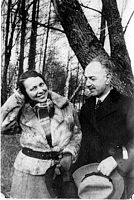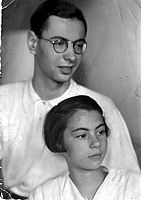F Fates: Dr. Hermann Neumark
von Lea Dittbrenner und Signe Olesen
 On the south side of today's Lenné Passagen, there is a Stumbling Stone in the ground for Dr Hermann Neumark. These days one can come upon Stumbling Stones on many footpaths and squares in wide areas of Europe. In Germany over 22,000 Stumbling Stones were laid up until 2010, 67 of them in Frankfurt (Oder). But what exactly are Stumbling Stones? We ask Carsten Roman Höft, of the Historischer Verein (History Society). He is the face behind the Stumbling Stones initiative in Frankfurt (Oder).
On the south side of today's Lenné Passagen, there is a Stumbling Stone in the ground for Dr Hermann Neumark. These days one can come upon Stumbling Stones on many footpaths and squares in wide areas of Europe. In Germany over 22,000 Stumbling Stones were laid up until 2010, 67 of them in Frankfurt (Oder). But what exactly are Stumbling Stones? We ask Carsten Roman Höft, of the Historischer Verein (History Society). He is the face behind the Stumbling Stones initiative in Frankfurt (Oder).
"Stumbling Stones are an initiative and project of the Cologne artist Gunter Demnig. A Stumbling Stone is a ten-by-ten centimetre concrete block with a brass plate implanted in it, on which are the researched data of a victim. A Stumbling Stone, laid in the path in front of his or her last address, or near it, gives brief information on the victim. It should encourage contemplation. That Stumbling Stones can be found everywhere makes clear that National Socialist terror found its victims everywhere.
The Stumbling Stones initiative in Frankfurt (Oder) is made up of Gerd Hoffmann from the Bund der Antifaschisten (Antifascist League), Frank Hühner of Aktionsplan gegen Rechts, and me, Carsten Höft, member of the Historical Society of Frankfurt (Oder). Then of course there are further supporters, like the city government of Frankfurt (Oder), who grant authorisations for laying stones and the relevant preparations. The city councillors who support the initiative are very important too. Then of course there are still more supporters, like the European University Viadrina, the Institute for Applied History, and, very importantly, citizens of Frankfurt (Oder), who become sponsors and also look after the stones once they are laid, as cleaning sponsors."
 Now let's turn again to Dr Hermann Neumark.
Dr Hermann Neumark is a paediatrician and has his practice at Wilhelmplatz 24, on the corner of Rosenstraße, now the south side of the Lenné Passagen. He also works as senior physician at the city children's home in Frankfurt (Oder). Alongside those of other Jewish doctors, his name above all is defining for the Frankfurt of the 1920s and 30s. He enjoys great respect and popularity among the citizens of Frankfurt because he cares for the poor children of the city.
Now let's turn again to Dr Hermann Neumark.
Dr Hermann Neumark is a paediatrician and has his practice at Wilhelmplatz 24, on the corner of Rosenstraße, now the south side of the Lenné Passagen. He also works as senior physician at the city children's home in Frankfurt (Oder). Alongside those of other Jewish doctors, his name above all is defining for the Frankfurt of the 1920s and 30s. He enjoys great respect and popularity among the citizens of Frankfurt because he cares for the poor children of the city.
 Er genießt bei den Frankfurter Bürgern großes Ansehen und Beliebtheit, weil er sich auch um die armen Kinder der Stadt bemüht. Er genießt bei den Frankfurter Bürgern großes Ansehen und Beliebtheit, weil er sich auch um die armen Kinder der Stadt bemüht.
In the course of the National Socialist takeover of power, Dr Neumark must give up his occupation in the city hospital and children's home because of his Jewish faith. After that, he and his family of four depend on the income from the private practice, meaning the family has now only a little money. However, unlike other Jewish families, they decide not to leave Frankfurt.
Dr Neumark's daughter, Ada Brodsky, describes her childhood as a Jew in the Frankfurt (Oder) of the 1930s in the report "Banished home". She tells of an everyday life distinguished by molestation on the street, discrimination, and intimidation at school:
"I recall a particularly unpleasant, if isolated, incident in the fourth class at school. Our form teacher, a dashing young man called Klauer, who generally behaved in a friendly manner towards Jewish pupils, called me to the front of the class in a German lesson and told the "pure bred" Kriemhild to stand next to me. He told the other pupils to inspect us carefully and then commented, "you see, that is Kriemhild, a classic Germanic type, big, blond, with a long skull, rather slow in her thinking. Next to her: Ada, all of whose strengths are found in her head, in typical Jewish style, to the detriment of all other qualities, as you can clearly see in her stunted body."
Although these intimidations in school are a decisive part of her childhood, Ada has a lot of friends in Frankfurt. They defend her and take her side if anyone is unfair to her. Ada Brodsky also finds a place of retreat in music and literature.
"I've already said that for us children the threats and adversities of life in the Third Reich remained superficial. The support we got from our parental home and Jewish community life safeguarded us from receiving the "Untermensch" status accorded to people of our racial background with anything other than superior sarcasm. "But I'm proud of being Jewish," we thought, when we were pursued with insults, and the bravest of us even mumbled it, but quietly so that it couldn't be understood."
Discrimination of Jews in Frankfurt continues to increase. Dr Neumark does now try to organise his family's emigration to Palestine. In 1937 this emigration is almost impossible. There is only a possibility for the children, Ada Brodsky and her brother. He goes to the Conservatory in Jerusalem as part of his music studies. She is able to go to Palestine in a transportation of children, and has to prepare herself in the following way:
"On a property not far from Berlin we were prepared for our new existence in Palestine. We worked in the house, the garden and the fields, Learned Hebrew, sang, danced Palestinian folk dances and talked our heads off. When the camp was finished, they revealed that for us fifty children there were twenty-five certificates. The camp leaders, young people of twenty-one, had to decide who left and who stayed. Luckily for them they didn't know back then that they had to decide on life or death."
Ada Brodsky is chosen as one of the twenty-five children and has to say goodbye to her parents. Shortly afterwards, in the Crystal Night pogrom, her father, Dr Neumann is arrested and taken to Sachsenhausen. However, through good connections he and his wife manage to get certificates for emigration to Palestine after half a year.
Dr Neumark dies in Palestine in 1947. Today there is a Stumbling Stone in his memory and that of his wife at Wilhelmplatz 24 in Frankfurt (Oder). Ada Brodsky lives in Jerusalem today and works as a translator of German poetry.
Signe Olesen and Lea Dittbrenner, students at the European University Viadrina
|